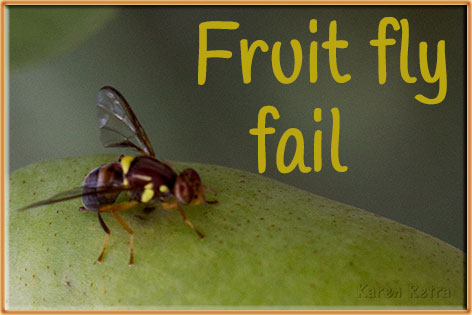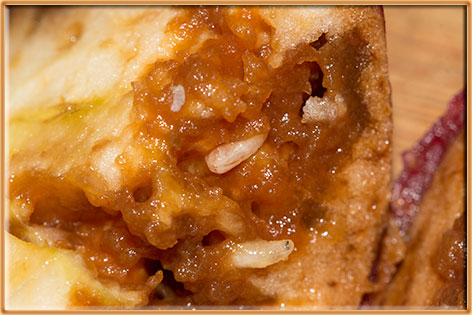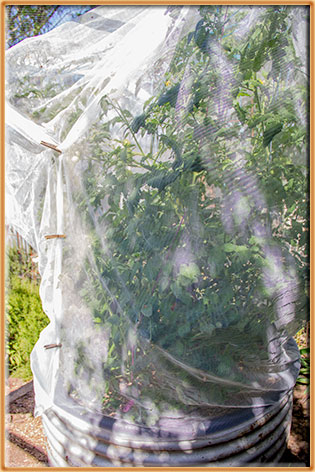Learning is one of the best things about ‘teaching’
/I learnt a lot from this permaculture class ... and I was one of the teachers!
Read MoreKaren Retra: notes of a neighbourhood naturalist in Albury, Australia. Particularly native bees, nature and garden.
I learnt a lot from this permaculture class ... and I was one of the teachers!
Read MoreA class combining permaculture and ESOL (English for speakers of other languages). Building language skills, growing food and having a good time!
Read MoreColour and congratulations all 'round!
Read MoreDespite considering myself well on top of the fruit fly threat, this season they got one over me!

It's frustrating as I'm well aware of both the damage fruit fly can cause and how to avoid it. Some years ago, when fruit fly was new to our area, there were many of us in tears over the destruction these insects can cause. They are particularly fond of tomatoes, but lots of other soft fruits can be targets, including capsicum, eggplant, pome and stone fruits, citrus, berries, figs and more.
We use exclusion nets and bags to put a barrier between our fruit and the fruit flies at our place. In theory the nets and bags go on as soon as pollination has occurred and they stay there until we've finished harvesting. This gives us a 'set and forget' method to exclude fruit flies without needing to use a chemical, or to remember to reapply or refresh a bait/poison frequently. We've had a 100% success rate for fruit fly free fruit (say that three times fast!) over several years where we've used exclusion nets and bags.
What went wrong?
Unfortunately the weak link in this approach is the human element. I didn't have my eye on the ball early enough in the season. While most of our fruit trees were taken care of (see below), the early apples had well-formed fruit before I got around to bagging them. I couldn't see any sign of damage then, but when I harvested the ones pictured below in the week before Christmas, it was clear I had left my run too late seeking to protect them. By the way, this variety is Vista Bella; a fantastic sweet early apple sourced from Woodbridge Fruit Trees in Tassie. It's on dwarf rootstock and espaliered, so it takes up very little space - a great way to create room for (more) fruit trees in an urban garden.
I knew as I picked them that we were in trouble - but I can't resist a harvest photo, regardless!

The damage the fruit flies cause ...

... and a particularly damaged fruit, with the maggots (larvae) living it up inside.

From this little crop, I salvaged about 20% that were free of fruit fly. The rest were solarised in plastic bags to kill all the maggots - if you bury them alive they'll continue their lifecycle in the ground. Sigh!
Exclusion netting
We've netted our mini-orchard (15 fruit trees on dwarf rootstock, espaliered along four wires to about two metres high, in an area of about 5 metres wide by 15 metres long) so that they are within a tent of netting that we can walk into for harvesting and maintenance, and even let the chickens into to graze. The nets are supported by overhead wires, and joined by rolling the edges together, secured with wooden clothes pegs.

Believe it or not, it takes only about 15 minutes to get the nets on in spring even less to take them off again later. The first year we netted individual trees and tried to secure every little gap. However, the tightly wrapped trees were then hard to access to check or harvest and the wires of our espalier frame were tricky to integrate. We've since realised that fruit fly aren't overly determined to find a way through nets. Draping the net over a structure or tree and letting some excess have contact with the ground on all sides is sufficient to keep them out. Sometimes we use bricks or stones to hold the net down (particularly if the chooks are digging around and trying to get under there themselves) but it's by no means crucial. This spot is relatively protected, so even the wind in a storm doesn't usually cause problems for the netting.
For the wicking beds containing susceptible fruit, we also use nets to enclose the whole bed.

Exclusion bags
We have other fruit trees dotted in the backyard, and for these I use exclusion bags. These fabric bags, or in some cases mesh sleeves, are placed over the developing fruit, instead of netting a whole tree. I find the bags more fiddly to manage than netting a whole tree (or mini orchard!), but they too can deliver a harvest safe from the dreaded fruit flies. They also allow you leave part of the plant uncovered, which is useful if you want to let the pollinators continue to have access to new flowers, while you protect the developing fruit.

Photos: Mesh sleeve (above) and fabric bags (below)

And yes, I will also sometimes take a gamble and hope I can get away without protecting some things - but with my netted beds/trees as the fall-back; I won't risk a whole crop. Cherry and yellow mini pear tomatoes tend to be less attractive to fruit fly. So if they volunteer (self-sow) in a non-netted bed I might let them go and just be vigilant to ensure I remove them if there's any sign of fruit fly strike. (Yes, I know, some people get away with everything, every year, but I'm afraid that's not the case at our place ... and yes, even the cherry tomatoes have taken a hit previously!).
If you're after more information about excluding fruit fly from your home grown produce, you might like to check out the Seed Savers Albury-Wodonga fact sheet on fruit fly, which you can grab here. It includes where to source exclusion products online and locally. Or visit preventfruitfly.com.au, with information for gardeners across Australia. If you're reading this in a fruit fly free area, well lucky you! I hope they don't ever make it to your place!
I'm very disappointed to concede defeat even on this relatively small front in the 'war on fruit fly'. However, both the mini orchard netting and wicking bed nets were on in good time. We're looking to harvest some wonderful apples, pears, quinces and plums (blood plums already; another tree to go) from the mini orchard, and have tomatoes, eggplant, capsicums and more currently being harvested from the (netted!) wicking beds.
As for me, this latest little brush with the pesky critters has provided plenty of motivation to ensure I get ALL my exclusion done early in coming seasons!
Karen Retra. A neighbourhood naturalist, home gardener and native bee tragic.

Hi, I'm Karen ... a neighbourhood naturalist, home gardener and native bee tragic. Read more
Like to receive new posts
by email?
Content on this site is subject to a Creative Commons license - CC BY-NC-SA-3.0.
If in doubt, please contact me to request the use of my material.